Multi-Scale Seismic Measurements for Site Characterization and CO2 Monitoring in an Enhanced Oil Recovery/Carbon Capture, Utilization, and Sequestration Project, Farnsworth Field, Texas
Abstract
:1. Introduction
2. 3D Surface Seismic
2.1. Data Acquisition
2.2. Data Processing
2.3. Results of the 3D Survey
3. Vertical Seismic Profile
3.1. Data Acquisition
3.2. Data Processing
- Build 3D model using two well (13-10A and 14-01) check-shot arrival times, which highlight the velocity structure;
- One-dimensional inversion using near-offset travel times from both wells;
- Estimate 1D VTI parameters using 3D VSP travel times;
- Three-dimensional tomographic inversion to update Vp;
- CIP Tomography to update Vp below receivers.
3.3. Results of the VSP
3.3.1. Timelapse Analysis
3.3.2. Displacement Field
4. Cross-Well Seismic Tomography
4.1. Data Processing
4.2. Results of Cross-Well Tomography
5. Discussion
6. Conclusions
Author Contributions
Funding
Data Availability Statement
Conflicts of Interest
References
- Chapman, W.L.; Brown, G.L.; Fair, D.W. The Vibroseis system; a high-frequency tool. Geophysics 1981, 46, 1657–1666. [Google Scholar] [CrossRef]
- Bagaini, C. Acquisition and processing of simultaneous vibroseis data. Geophys. Prospect. 2010, 58, 81–100. [Google Scholar] [CrossRef]
- Berkhout, A.G. Changing the mindset in seismic data acquisition. Lead. Edge 2008, 27, 924–938. [Google Scholar] [CrossRef]
- Lindseth, R.O. Digital Processing of Geophysical Data—A Review; Society of Exploration Geophysicists: Tulsa, OK, USA, 1968. [Google Scholar]
- Lucia, F.J.; Kerans, C.; Jennings, J.W., Jr. Carbonate reservoir characterization. J. Pet. Technol. 2003, 55, 70–72. [Google Scholar] [CrossRef]
- Xu, Y.; Chang, J.; Liu, X.; Hu, Z.; Duan, X. Modeling a Multi-Parameter Interaction of Geophysical Controls for Production Optimization in Gas Shale Systems. ACS Omega 2023, 8, 3367–3384. [Google Scholar] [CrossRef]
- Alvarado, V.; Manrique, E. Enhanced oil recovery: An update review. Energies 2010, 3, 1529–1575. [Google Scholar] [CrossRef]
- Thomas, S. Enhanced oil recovery—An overview. Oil Gas Sci. Technol. Rev. IFP 2008, 63, 9–19. [Google Scholar] [CrossRef]
- Ampomah, W.; Balch, R.S.; Grigg, R.B.; McPherson, B.; Will, R.A.; Lee, S.Y.; Dai, Z.; Pan, F. Co-optimization of CO2-EOR and storage processes in mature oil reservoirs. Greenh. Gases Sci. Technol. 2017, 7, 128–142. [Google Scholar] [CrossRef]
- Ampomah, W.; Balch, R.; Cather, M.; Rose-Coss, D.; Dai, Z.; Heath, J.; Dewers, T.; Mozley, P. Evaluation of CO2 storage mechanisms in CO2 enhanced oil recovery sites: Application to morrow sandstone reservoir. Energy Fuels 2016, 30, 8545–8555. [Google Scholar] [CrossRef]
- Middleton, R.S.; Bielicki, J.M. A scalable infrastructure model for carbon capture and storage: SimCCS. Energy Policy 2009, 37, 1052–1060. [Google Scholar] [CrossRef]
- McCormack, K.L.; Edelman, E.; Moodie, N.; McPherson, B.J.; Paulsson, B.; He, R. The Design of a Downhole Source Tomography Experiment for the Detection of CO2 Plumes in the Subsurface. In Proceedings of the 57th US Rock Mechanics/Geomechanics Symposium, Atlanta, GA, USA, 25–28 June 2023; OnePetro: Richardson, TX, USA, 2023. [Google Scholar]
- Balch, R.; McPherson, B. Associated Storage with Enhanced Oil Recovery: A Large-Scale Carbon Capture, Utilization, and Storage Demonstration in Farnsworth, Texas, USA. In Geophysical Monitoring for Geologic Carbon Storage; Wiley Online Library: Hoboken, NJ, USA, 2022; pp. 343–360. [Google Scholar]
- Balch, R.; McPherson, B. Integrating enhanced oil recovery and carbon capture and storage projects: A case study at Farnsworth field, Texas. In Proceedings of the SPE Western Regional Meeting, Anchorage, AK, USA, 23–26 May 2016; SPE: Richardson, TX, USA, 2016; p. SPE-180408. [Google Scholar]
- Cather, M.; Rose-Coss, D.; Gallagher, S.; Trujillo, N.; Cather, S.; Hollingworth, R.S.; Mozley, P.; Leary, R.J. Deposition, diagenesis, and sequence stratigraphy of the pennsylvanian morrowan and atokan intervals at farnsworth unit. Energies 2021, 14, 1057. [Google Scholar] [CrossRef]
- Egan, M.S.; Seissiger, J.; Salama, A.; El-Kaseeh, G. The influence of spatial sampling on resolution. CSEG Rec. 2010, 35, 29–33. [Google Scholar]
- Thomsen, L. Weak elastic anisotropy. Geophysics 1986, 51, 1954–1966. [Google Scholar] [CrossRef]
- Kragh, E.D.; Christie, P. Seismic repeatability, normalized rms, and predictability. Lead. Edge 2002, 21, 640–647. [Google Scholar] [CrossRef]
- Nugraha, A.D.; Shiddiqi, H.A.; Widiyantoro, S.; Thurber, C.H.; Pesicek, J.D.; Zhang, H.; Wiyono, S.H.; Ramdhan, M.; Wandono, W.; Irsyam, M. Hypocenter relocation along the Sunda Arc in Indonesia, using a 3D seismic-velocity model. Seismol. Res. Lett. 2018, 89, 603–612. [Google Scholar] [CrossRef]
- Pesicek, J.D.; Thurber, C.H.; Zhang, H.; DeShon, H.R.; Engdahl, E.R.; Widiyantoro, S. Teleseismic double-difference relocation of earthquakes along the Sumatra-Andaman subduction zone using a 3-D model. J. Geophys. Res. Solid Earth 2010, 115, B10303. [Google Scholar] [CrossRef]
- Lin, G.; Shearer, P.M.; Hauksson, E. Applying a three-dimensional velocity model, waveform cross correlation, and cluster analysis to locate southern California seismicity from 1981 to 2005. J. Geophys. Res. Solid Earth 2007, 112, B12309. [Google Scholar] [CrossRef]
- Qin, Y.; Li, J.; Huang, L.; Gao, K.; Li, D.; Chen, T.; Bratton, T.; El-Kaseeh, G.; Ampomah, W.; Ispirescu, T.; et al. Microseismic Monitoring at the Farnsworth CO2-EOR Field. Energies 2023, 16, 4177. [Google Scholar] [CrossRef]
- Ali, M.Y.; Barkat, B.; Berteussen, K.A.; Small, J. A low-frequency passive seismic array experiment over an onshore oil field in Abu Dhabi, United Arab Emirates. Geophysics 2013, 78, B159–B176. [Google Scholar] [CrossRef]
- Zhu, W.; Mousavi, S.M.; Beroza, G.C. Seismic signal denoising and decomposition using deep neural networks. IEEE Trans. Geosci. Remote Sens. 2019, 57, 9476–9488. [Google Scholar] [CrossRef]
- Aguiar-Conraria, L.; Soares, M.J. The Continuous Wavelet Transform: A Primer; (No. 16/2011); NIPE-Universidade do Minho: Braga, Portugal, 2011. [Google Scholar]
- Mousavi, S.M.; Langston, C.A.; Horton, S.P. Automatic microseismic denoising and onset detection using the synchrosqueezed continuous wavelet transform. Geophysics 2016, 81, V341–V355. [Google Scholar] [CrossRef]
- Ajo-Franklin, J.B.; Peterson, J.; Doetsch, J.; Daley, T.M. High-resolution characterization of a CO2 plume using crosswell seismic tomography: Cranfield, MS, USA. Int. J. Greenh. Gas Control 2013, 18, 497–509. [Google Scholar] [CrossRef]
- Alfi, M.; Hosseini, S.A.; Alfi, M.; Shakiba, M. Effectiveness of 4D seismic data to monitor CO2 plume in Cranfield CO2-EOR project. In Proceedings of the Carbon Management Technology Conference, Sugar Land, TX, USA, 17–19 November 2015; p. CMTC-439559. [Google Scholar]
- Daley, T.M.; Myer, L.R.; Peterson, J.E.; Majer, E.L.; Hoversten, G.M. Time-lapse crosswell seismic and VSP monitoring of injected CO i2n a brine aquifer. Environ. Geol. 2008, 54, 1657–1665. [Google Scholar] [CrossRef]
- Dodds, K.; Krahenbuhl, R.; Reitz, A.; Li, Y.; Hovorka, S. Evaluating time-lapse borehole gravity for CO2 plume detection at SECARB Cranfield. Int. J. Greenh. Gas Control 2013, 18, 421–429. [Google Scholar] [CrossRef]
- Freifeld, B.M.; Daley, T.M.; Hovorka, S.D.; Henninges, J.; Underschultz, J.; Sharma, S. Recent advances in well-based monitoring of CO2 sequestration. Energy Procedia 2009, 1, 2277–2284. [Google Scholar] [CrossRef]
- Zhang, F.; Juhlin, C.; Cosma, C.; Tryggvason, A.; Pratt, R.G. Cross-well seismic waveform tomography for monitoring CO2 injection: A case study from the Ketzin Site, Germany. Geophys. J. Int. 2012, 189, 629–646. [Google Scholar] [CrossRef]
- Böhm, G.; Carcione, J.M.; Gei, D.; Picotti, S.; Michelini, A. Cross-well seismic and electromagnetic tomography for CO2 detection and monitoring in a saline aquifer. J. Pet. Sci. Eng. 2015, 133, 245–257. [Google Scholar] [CrossRef]
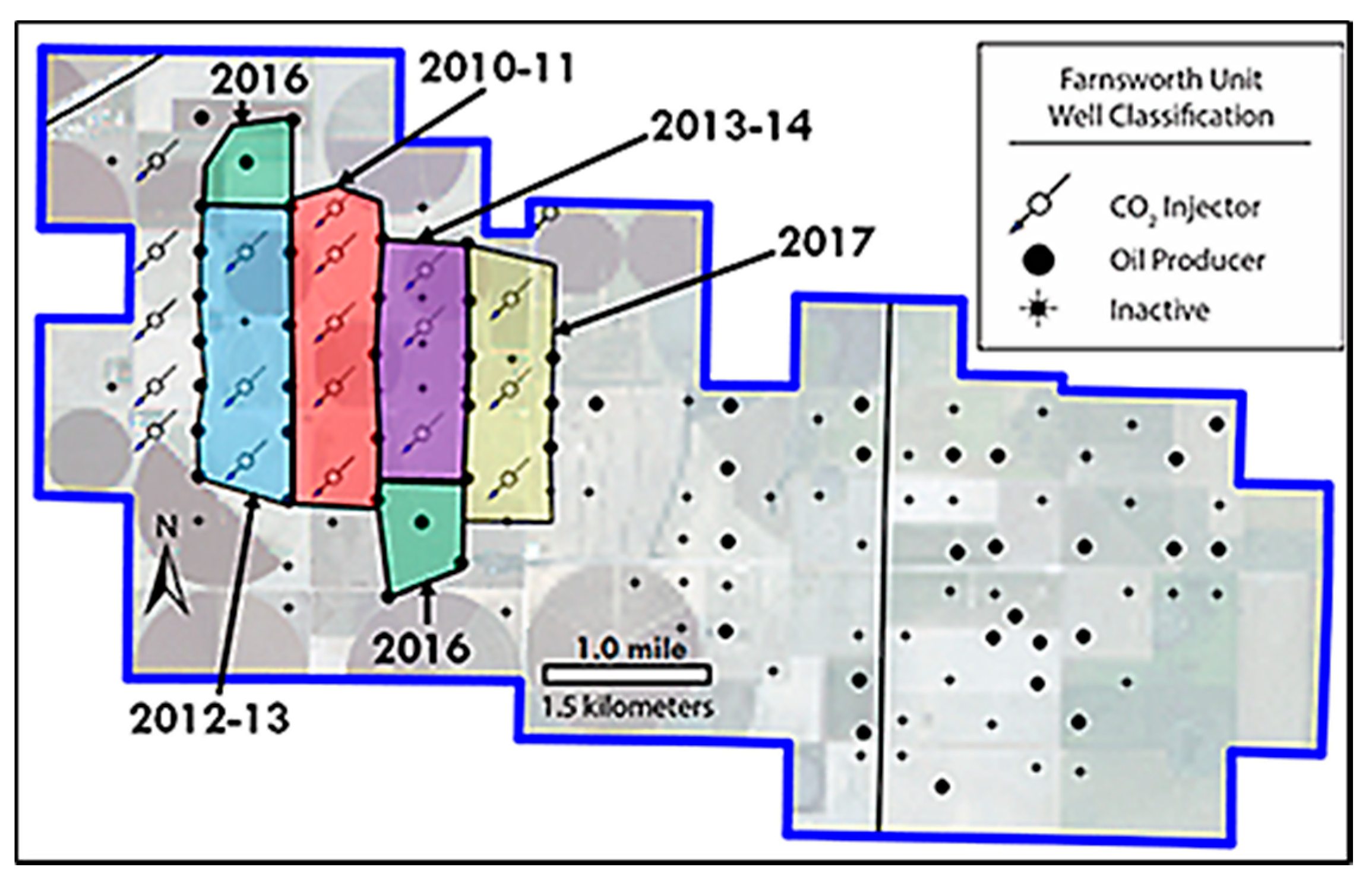
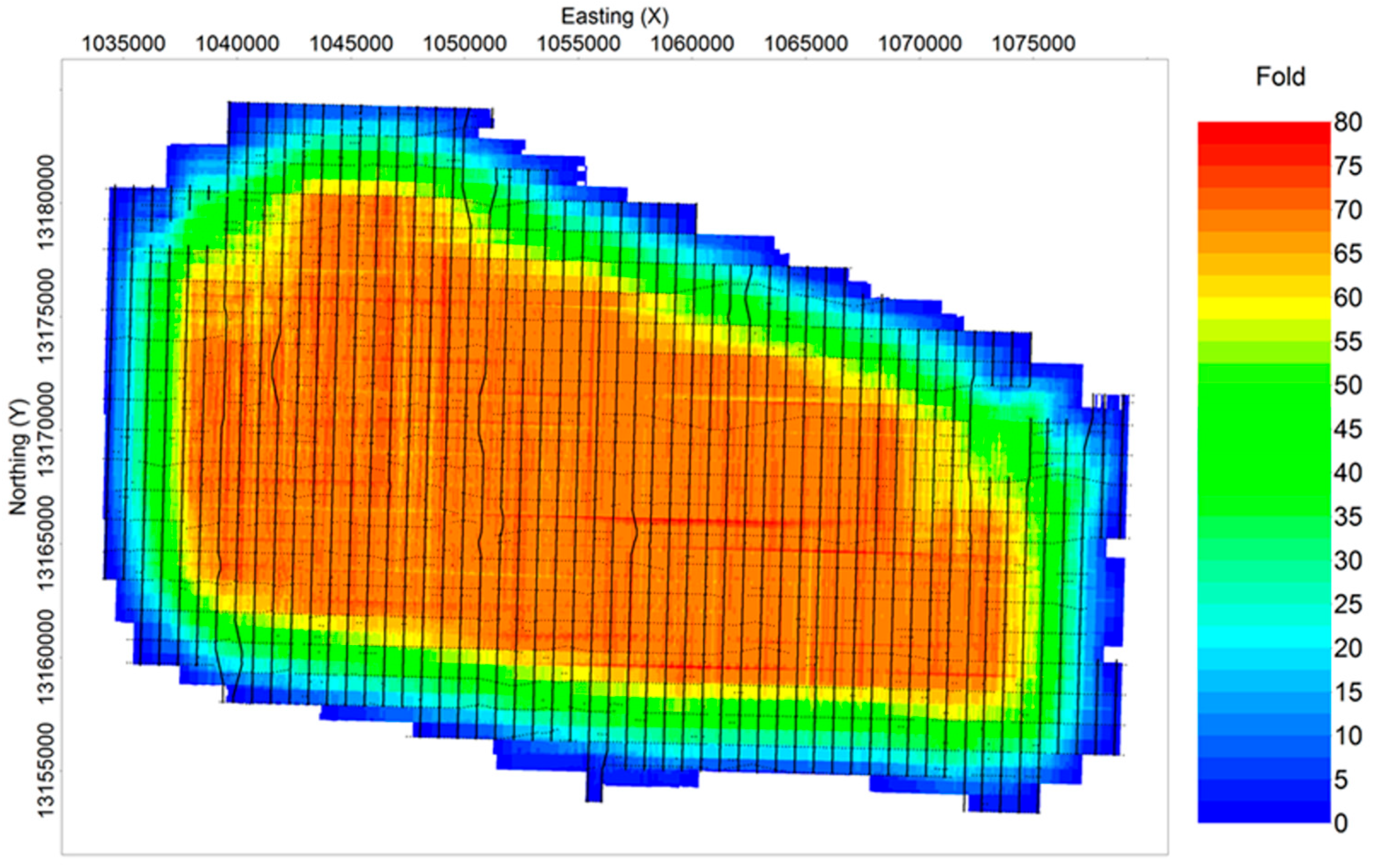


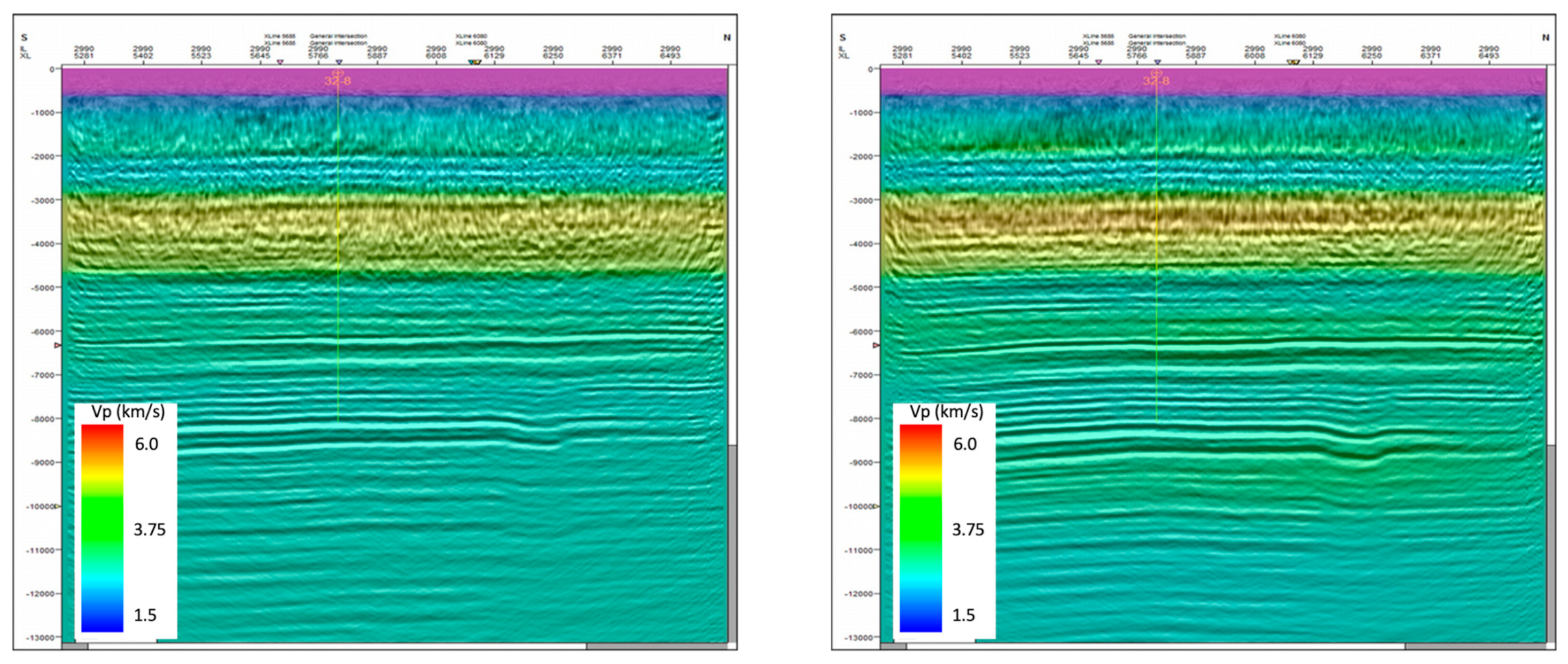


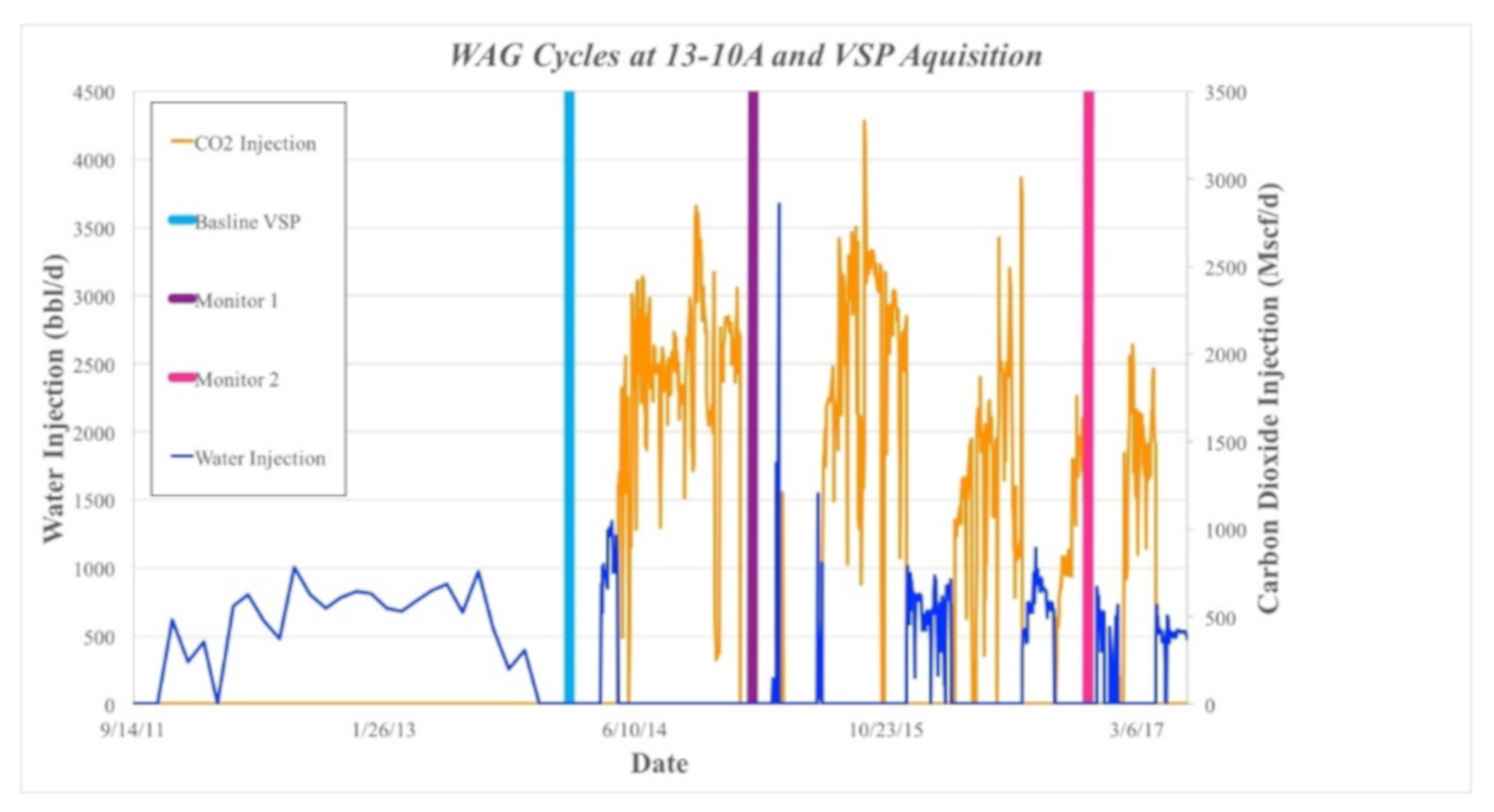

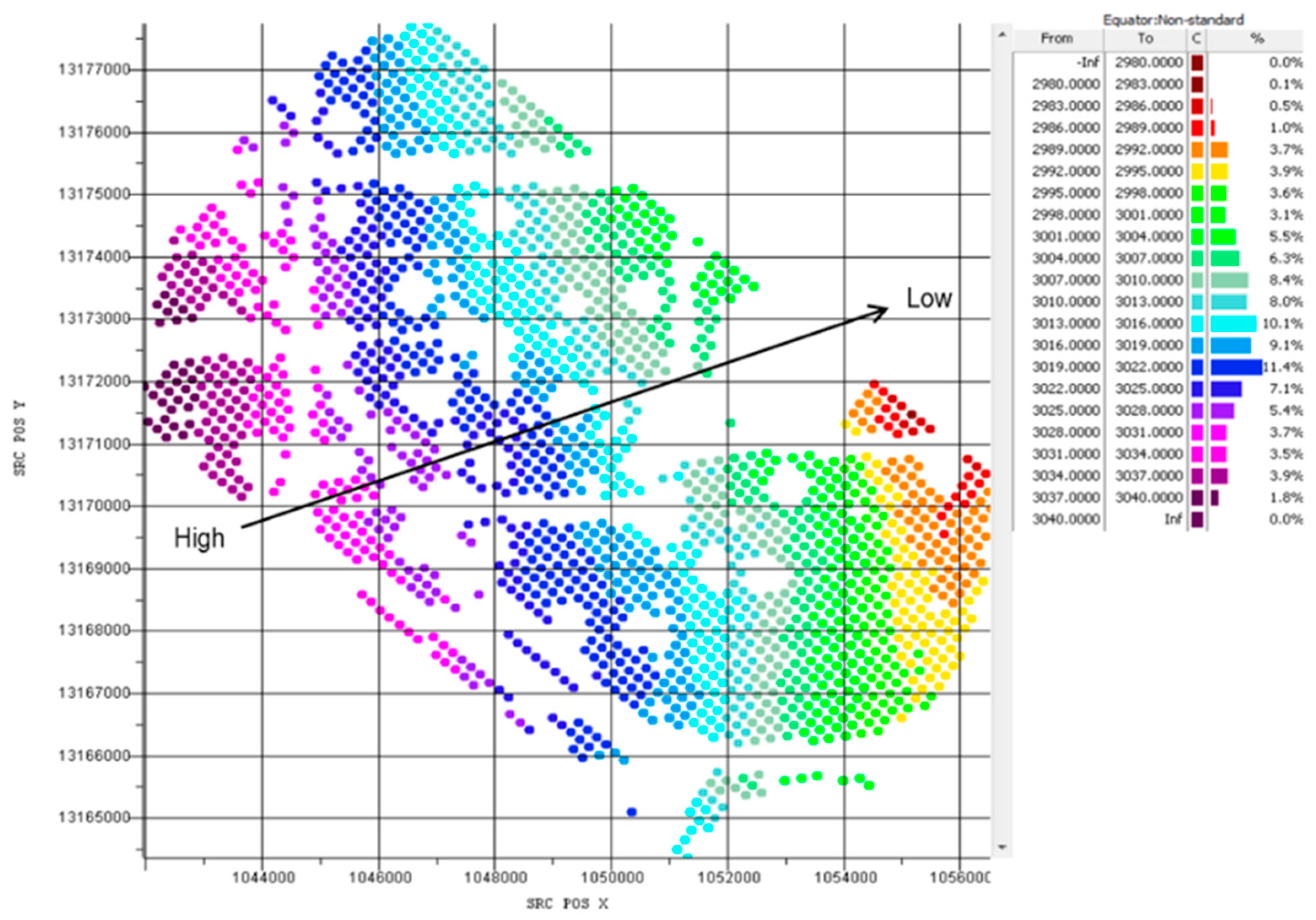


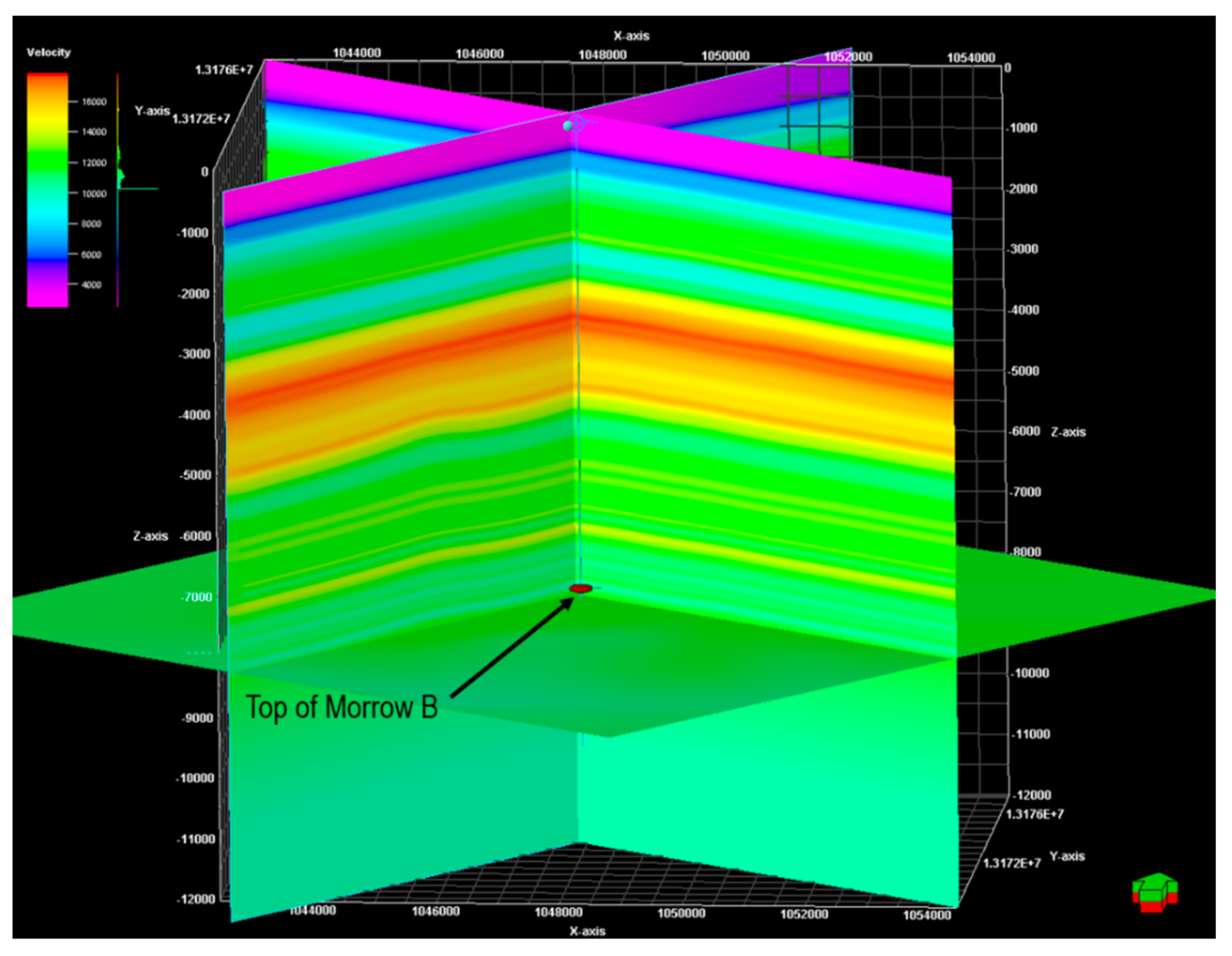





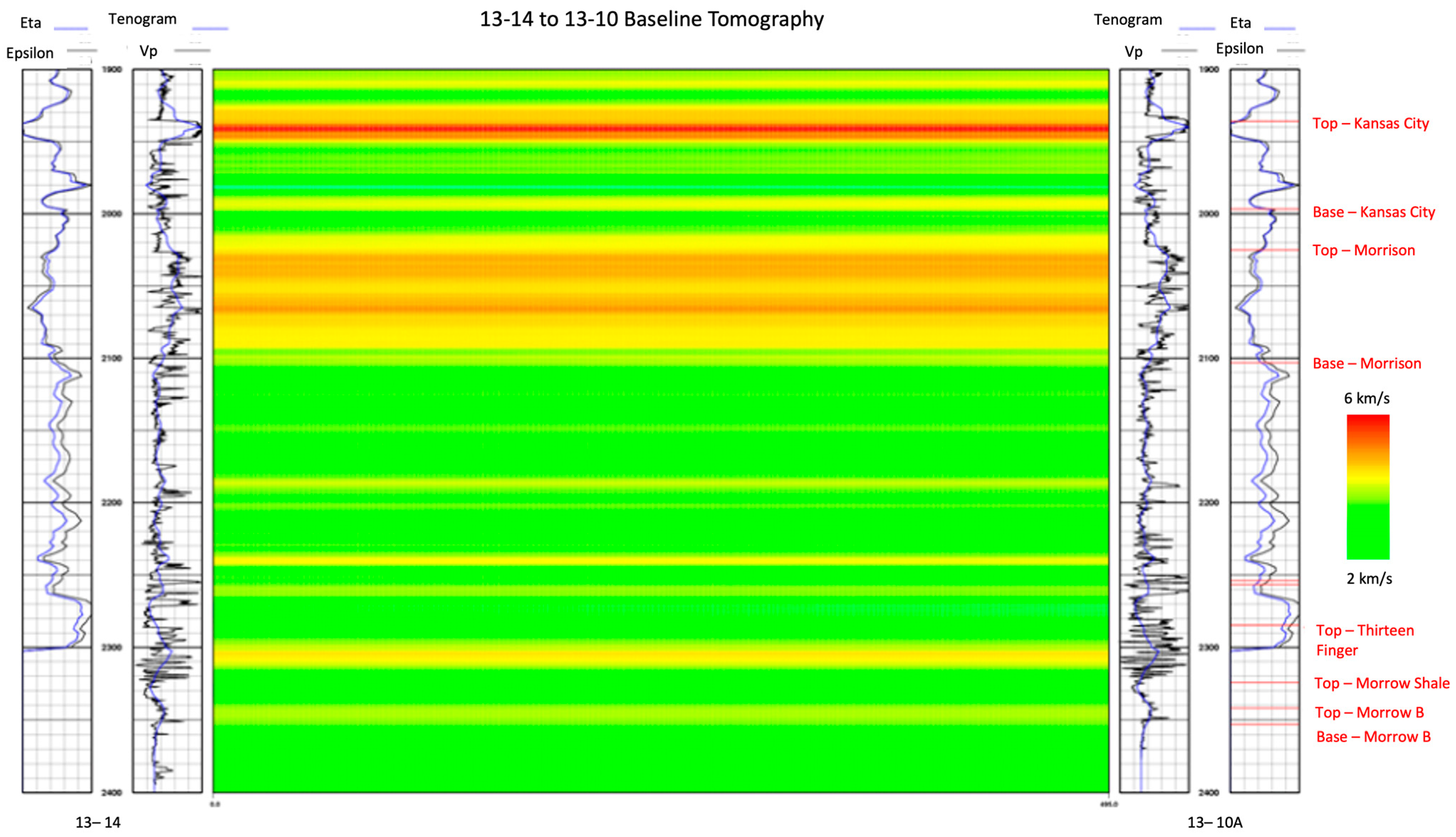
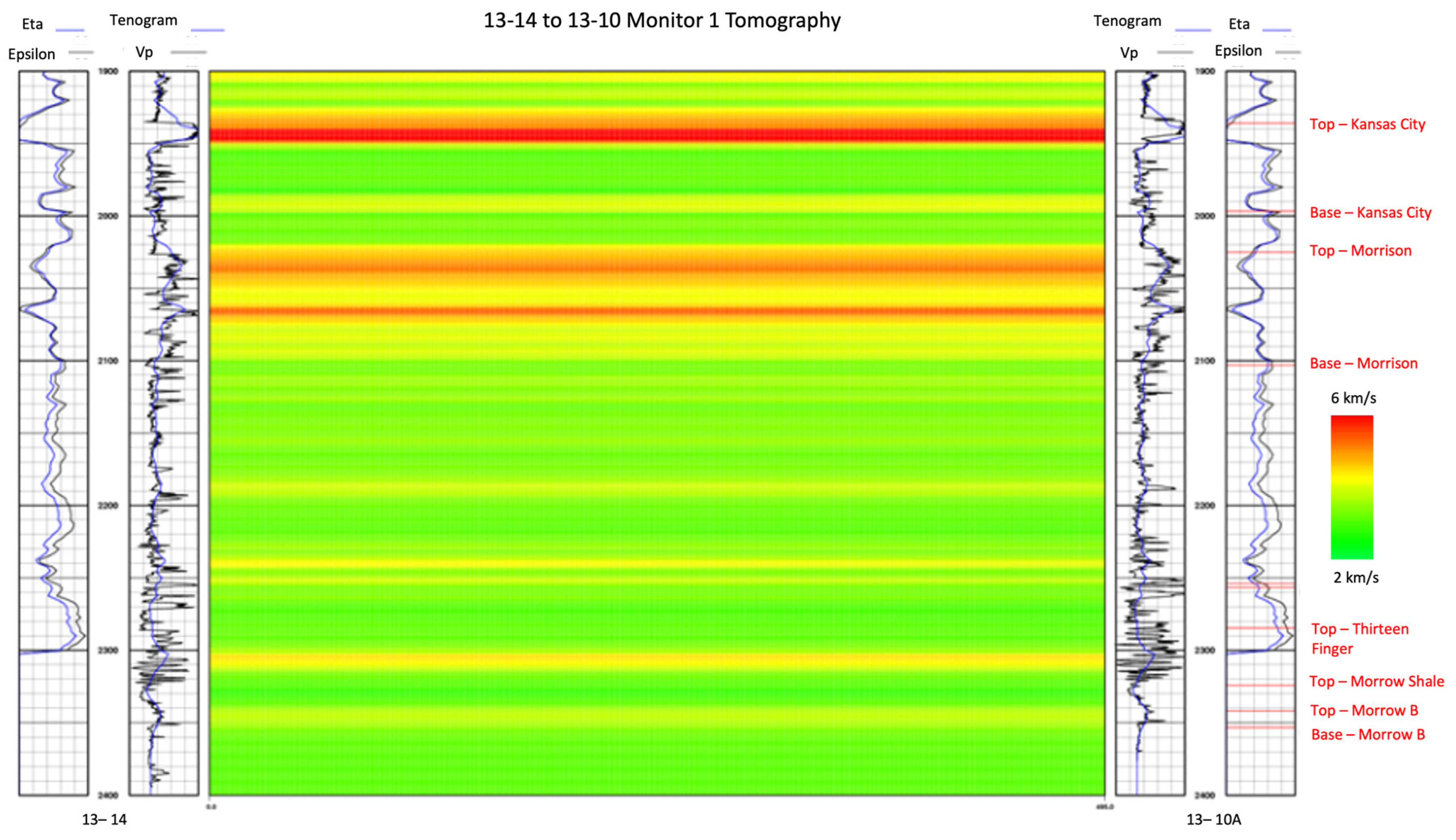
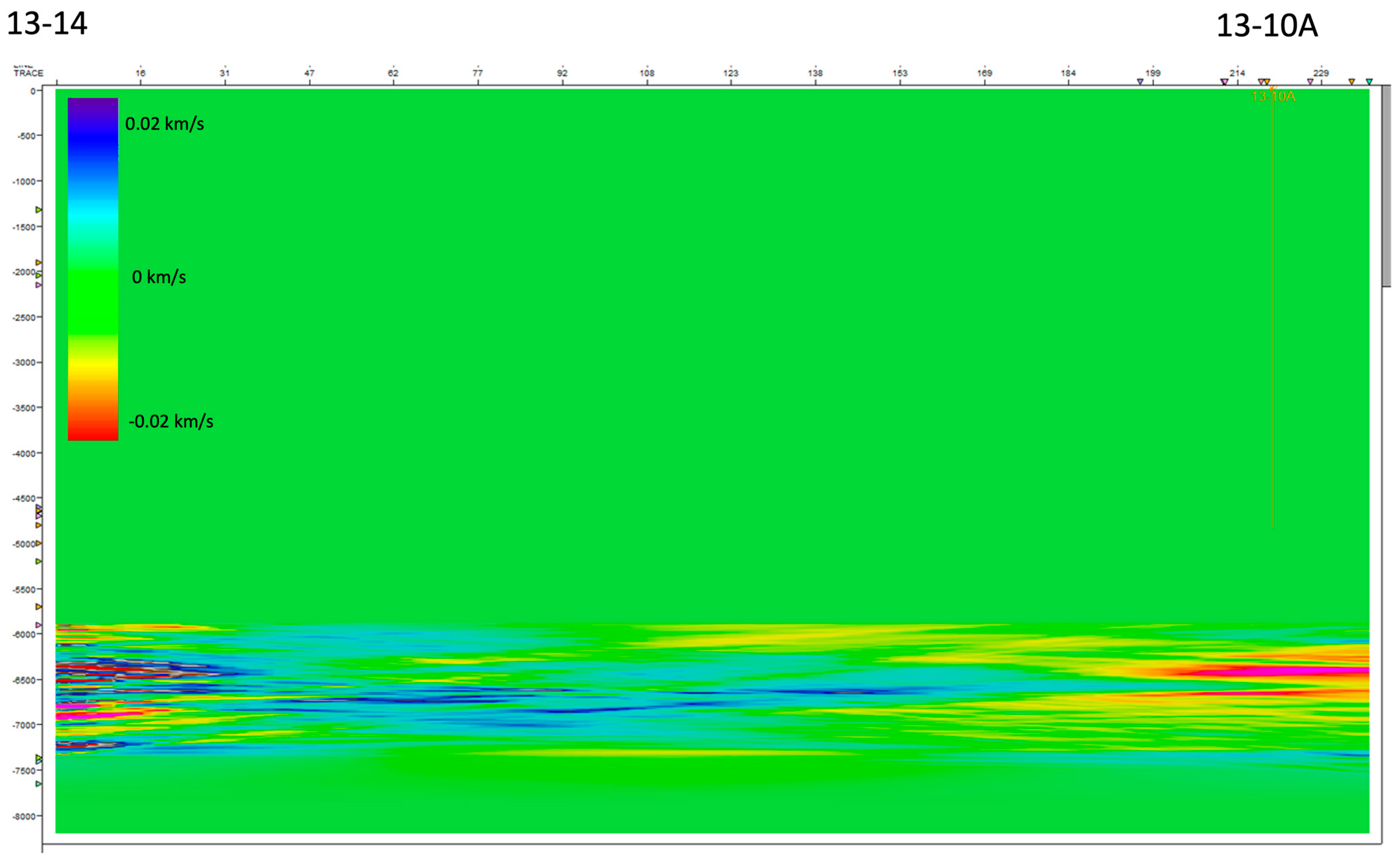
| Processing Sequence | Description |
|---|---|
| Geometry Update | Populate seismic trace headers with geometry information (source and receiver coordinates and elevations) |
| Statics | Refraction Tomography |
| Noise Attenuation |
|
| Surface-Consistent Spectrally Constrained Deconvolution | Apply frequency limited deconvolution |
| Model-Based Wavelet Processing (MBWP) | Convolutional models containing components of the seismic wavelet and information about the noise in the data. |
| Residual Statics | Correct for residual misalignment of traces |
| Anomalous Amplitude Attenuation (AAA) | Shot, receiver and common mid-point (CMP) domains |
| Regularization | Fill gaps in data before imaging |
| Kirchhoff Pre-Stack Anisotropic Time Migration | Produce 3D time migration stack volume |
Disclaimer/Publisher’s Note: The statements, opinions and data contained in all publications are solely those of the individual author(s) and contributor(s) and not of MDPI and/or the editor(s). MDPI and/or the editor(s) disclaim responsibility for any injury to people or property resulting from any ideas, methods, instructions or products referred to in the content. |
© 2023 by the authors. Licensee MDPI, Basel, Switzerland. This article is an open access article distributed under the terms and conditions of the Creative Commons Attribution (CC BY) license (https://creativecommons.org/licenses/by/4.0/).
Share and Cite
El-kaseeh, G.; McCormack, K.L. Multi-Scale Seismic Measurements for Site Characterization and CO2 Monitoring in an Enhanced Oil Recovery/Carbon Capture, Utilization, and Sequestration Project, Farnsworth Field, Texas. Energies 2023, 16, 7159. https://doi.org/10.3390/en16207159
El-kaseeh G, McCormack KL. Multi-Scale Seismic Measurements for Site Characterization and CO2 Monitoring in an Enhanced Oil Recovery/Carbon Capture, Utilization, and Sequestration Project, Farnsworth Field, Texas. Energies. 2023; 16(20):7159. https://doi.org/10.3390/en16207159
Chicago/Turabian StyleEl-kaseeh, George, and Kevin L. McCormack. 2023. "Multi-Scale Seismic Measurements for Site Characterization and CO2 Monitoring in an Enhanced Oil Recovery/Carbon Capture, Utilization, and Sequestration Project, Farnsworth Field, Texas" Energies 16, no. 20: 7159. https://doi.org/10.3390/en16207159
APA StyleEl-kaseeh, G., & McCormack, K. L. (2023). Multi-Scale Seismic Measurements for Site Characterization and CO2 Monitoring in an Enhanced Oil Recovery/Carbon Capture, Utilization, and Sequestration Project, Farnsworth Field, Texas. Energies, 16(20), 7159. https://doi.org/10.3390/en16207159





